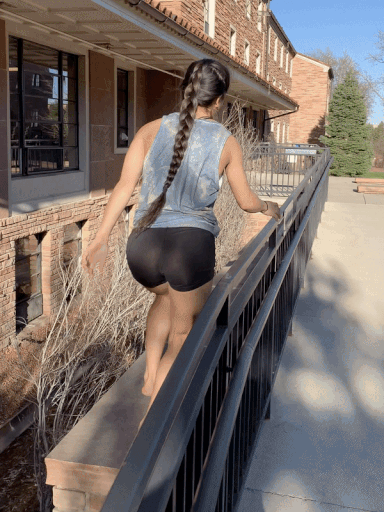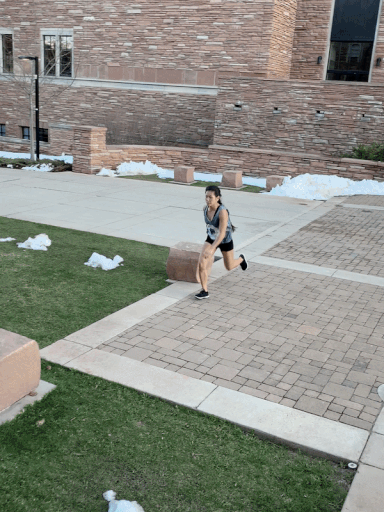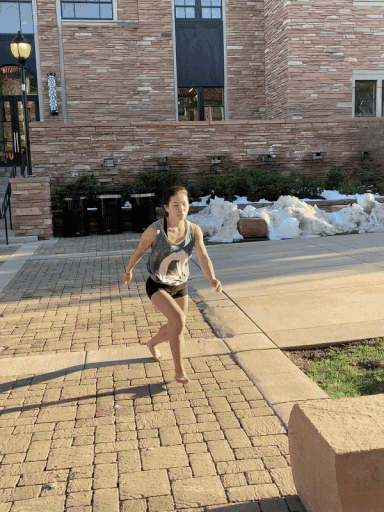After years of training and coaching gymnastics and cheer in Hawai’i, I started tricking in 2014. When I moved to Colorado in 2016, I began coaching at Apex Fort Collins––helping to build the acro/tricking program with my friend Sean Ingel. I spent the last year helping to build up the acro program at Apex Louisville, and have recently started mapping out our new Apex Remote acro program.
Tricking started as something that I did mostly because my friends tricked. It was fun and challenging, so I stuck with it. Coming from gymnastics where you’re told exactly what to do and how to do it, I relied on my friends to give me tricks to work on. Once I realized that I could do whatever I want, and shape my own progression, tricking had a whole new meaning to me. It became a creative outlet and I LOVED the freedom.
I love being able to use nothing but my own body to create cool shit. It’s fun to explore the possibilities of what the body is capable of in the areas of strength, mobility, and coordination. I’ve spent countless nights tricking alone until 1am to clear my mind. There’s also something magical about flipping and rolling around barefoot in the grass, with the sun gleaming. I love to create and I love to accomplish. Tricking allows me to do both.
What's martial arts tricking?
Martial arts tricking, or “tricking” for short, is an acrobatic movement art discipline that combines kicks from martial arts with flips and twists from gymnastics. It also incorporates various movements from capoeira, breakdancing, and wushu. The end goal is to create aesthetically-pleasing combinations of tricks. Tricking originated from martial artists who ventured outside the normal boundaries of their disciplines, looking to spice up their forms.
Similar to parkour, there’s no “perfect form” that you need to hit, and no control over what tricks you do. Even in tricking battles, no one dictates the type of movements the athletes choose to perform. This allows trickers to be creative and tricking to be an expression of one’s self.
Tricking is typically trained on flat surfaces such as a spring floor or grass, but can be done anywhere with open space. The concrete, sand, snow, you name it. The main obstacle in tricking is gravity.
View this post on InstagramA post shared by Taylor Carpenter (@tlynncarpenter) on May 30, 2019 at 5:46am PDT
My crossover to parkour
For two years, I worked at Apex Fort Collins without getting into parkour. I was too self-conscious and didn’t think I could do it. Most of my friends back home in Hawai’i did tricking, parkour, or both. I always thought parkour was interesting. Since I was a kid, I loved climbing trees and cliffs, jumping across lava rocks, and exploring in nature. However, the thought of doing it on manmade structures freaked me out, so I stuck with tricking.
About two years ago, I finally started learning parkour outside with Ryan. I wish I had started sooner.
Parkour gave me a new challenge. Being more environment-based than tricking, I was introduced to another world of endless challenges to try. Parkour showed me that I can go wherever I want to go. It encourages problem-solving and determination.
I was immediately drawn to speed parkour. I love the straightforwardness of time being the judge. For me, parkour is more of a mental challenge than tricking. There’s a lot more to think about than just what your body is doing. When you fail in tricking, you only have to worry about yourself and the ground. In parkour, there are other obstacles, dimensions, and consequences to consider.
Long story short, you’re not too old, too fat, too untalented, or too anything to start a new movement. If you’re interested in learning something new, do it. Don’t let anyone tell you that you can’t, including yourself.
View this post on InstagramA post shared by Taylor Carpenter (@tlynncarpenter) on Oct 21, 2019 at 11:25am PDT
Why cross-train with tricking?
Diving deep into different movement styles, and dabbling in others, gave me a greater appreciation for each discipline and all movement in general. Because parkour and tricking are both a mixture of different disciplines, training both makes me a more well-rounded athlete. Tricking gave me a different perspective to look at parkour with. It allowed me to use my strengths to excel, and it pointed out the weaknesses I had to work on.
Both tricking and parkour introduced me to communities full of like-minded people. Most of my closest friends came from tricking or other movement backgrounds. Besides giving you cool tricks to mix into your parkour lines with, tricking offers many other benefits:
- Improves air awareness and coordination.
- Works on mobility and flexibility (in a fun way).
- Develops single-leg strength and power.
- Builds rhythm, timing, and explosiveness.
- Challenges your mind. Similar to overcoming jumps in parkour. Tricking can be scary. Going heels over head isn’t the most natural action.
- Promotes barefoot training. Tricks are typically easier to do barefoot.
- Encourages creativity. Train your brain to be more creative and not be a sheep.
View this post on InstagramA post shared by Taylor Carpenter (@tlynncarpenter) on Mar 8, 2019 at 12:14am PST
Who can trick?
Anyone and everyone!
You don’t need formal martial arts or gymnastics training to get started. All you need is yourself, some space, and a positive attitude. There are many paths you can choose to level up your tricking game. You can focus on power moves or creativity. You don’t have to work on skills that you don’t want to. You get to choose your own adventure and determine your own growth 🌱
Interested in tricking but don’t know where to start? Here are some basic tricks and combos for beginners:
*DISCLAIMER* 🙃
- The clips and text below are not tutorials. Instead, they are meant to give you an idea of some tricking basics and inspire you to give it a try. If you’re interested in learning more, check out online tutorials and look for a tricking community/coach in your area! (or hit us up to join our new Apex Remote training programs!)
- This isn’t an attempt to take over tricking. It’s an attempt to build a stronger connection between the two disciplines/communities and promote training other movements ❤️ There are many benefits to cross-training different movement arts, and so many wonderful communities to engage with. Why wouldn’t we want more crossover? In the end, we all love movement.
12 tricks for beginners
* The trick names used below are commonly known and used, but some tricking communities may use slightly different terminology. Either way, the end result is the same 🙂
🦶 Round kick

- One of the most fundamental kicks that sets the basis for many different kicks and variations.
- Imagine a head-high (or waist-high 😉) target in front of you—try to spot and kick through the target.
- Chamber (bend) the kicking leg before extending the kick and re-chamber after the kick.
- Work both sides to encourage symmetry 🙂
⚓️ Hook kick

- Another one of the most fundamental kicks that sets the basis for many different kicks and variations.
- Like a round kick in reverse.
- Imagine a head-high (or waist-high 😉) target in front of you—try to spot and kick through the target.
- Chamber (bend) the kicking leg before extending the kick and re-chamber after the kick.
- Work both sides to encourage symmetry 🙂
🌪 Tornado kick
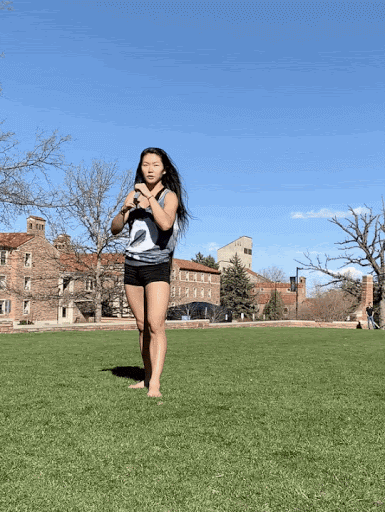
- AKA “cheat 360 round.”
- Starting to add more complexity—tornado kicks introduce the cheat takeoff (spinning 180°, then jumping off one foot) that opens the door to more complex kicks.
- Start as if you’re doing a hook kick, but instead of extending the kick, keep that leg chambered. Then jump and switch your feet while throwing a round kick towards the front.
- Think about kicking through the “target.”
🌙 Pop 360
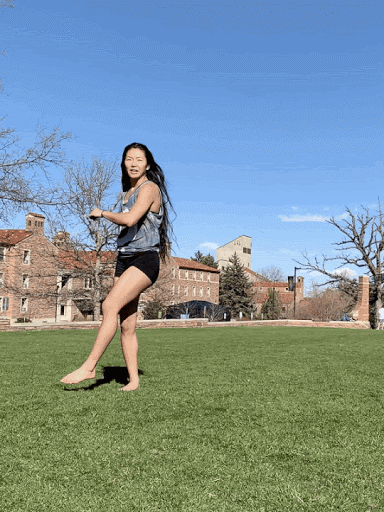
- AKA “pop 3” or “pop 180 crescent.”
- An introduction to the pop takeoff (two foot takeoff)—it’s a simple yet fancy looking kick that’s easy to throw into combos.
- Think of it as a 180° pivot followed by a 180° jump with an outside crescent kick.
- The sooner you can spot the front while turning, the easier it will be to orient yourself.
🤸♀️ Tricker cartwheel
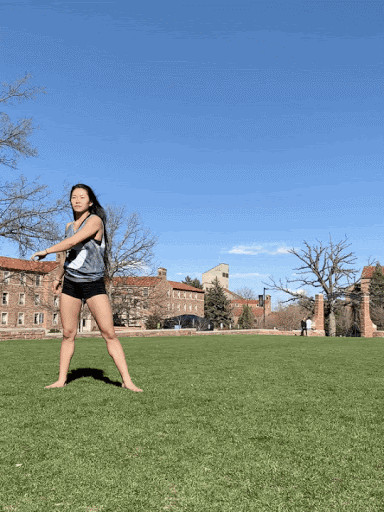
- Introduction to inversions (with two hands).
- A good place to start building coordination and comfort/confidence.
- Compared to gymnastics cartwheels which have a 180 stance change, tricker cartwheels move side-to-side. This allows it to be used as a powerful setup for other tricks.
- Slightly off-axis compared to a gymnastics cartwheel—your hips don’t need to go completely over your head.
- It can be used as a powerful setup, in combos, and is a good foundation for other tricks.
🤸♂️ Opposite side cartwheel
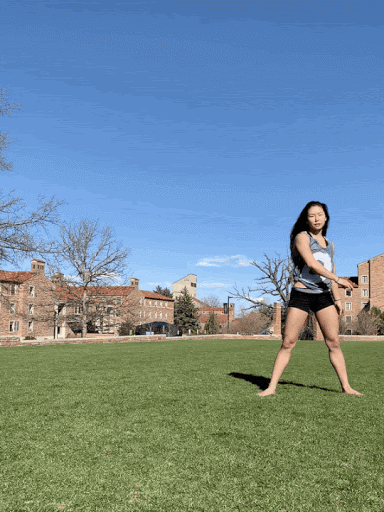
(my opposite side)
- Drill the dark side—it’s good to work both sides for basics 🙂
- Learning your opposite side cartwheel also makes it easier to learn gumbi (another strong set up).
- Focus on the same things as when doing your “good side” cartwheels.
- If you want to start on the adventure to gumbi, start to arch your opposite side cartwheel more and more.
🕷 Machine step
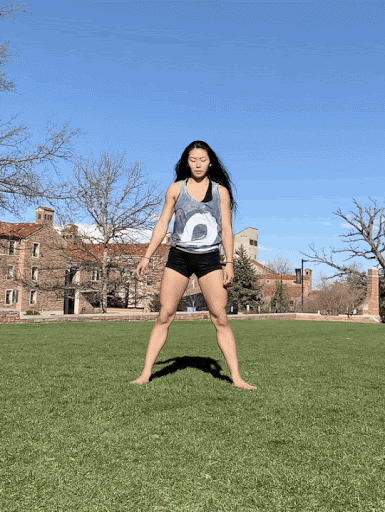
- AKA “transformer” or “touchdown spyder.”
- Simple transition that you can easily throw into tricking combos or parkour lines.
- Pick up one foot and replace it with your opposite side hand. As your second foot leaves the ground, replace it with your second hand. Then your first foot will come back to the ground followed by your second foot.
- “Hand-hand-foot-foot.”
🤚 Palm kick

- Similar to a cartwheel but take away the first hand and add a hook kick.
- This is where you can start to play with the cartwheel and add your own style.
- Reach across your body and down towards the ground. Spot the front and throw in a hook kick with your takeoff leg.
- If you’re not comfortable with going straight to one arm, practice cartwheels and take away your first hand sooner and sooner until you don’t need it anymore.
🛴 Scoot

- One of the most valuable moves to learn—it can be used in simple and advanced tricking combos, as a powerful set up for other tricks, or to interact with obstacles.
- Once in a lunge, reach your arm out in line with your hip and with your fingers pointed towards your back leg.
- Think about kicking your back leg through the little window that your front leg and arm make.
- Try scoots where you let your second leg swing through at the end (simulating a swing transition) and scoots where you plant both feet and jump up (simulating a pop take off).
🐵 Macaco
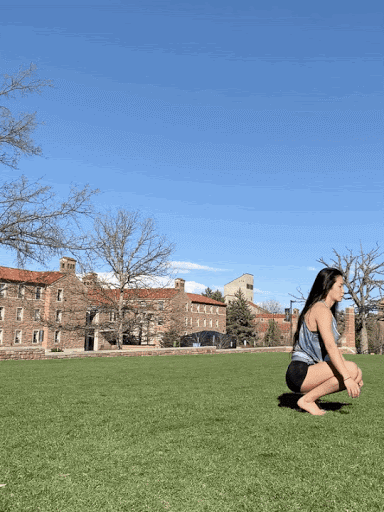
- Intro to moving backwards—macacos are good mental and physical prep for backwards inversion skills like back handsprings and back flips.
- Originating from capoeira, it can be used in tricking combos or to interact with obstacles.
- Reach one arm behind you, push your hips up to the sky while you jump, and reach over the top with your other arm.
- You don’t have to reach over the top at first—reach around the side and gradually make your way to reaching over the top. Some of the earlier progressions may feel more like a cartwheel.
🦋 Butterfly kick

- AKA “b-kick” 🐝
- An introduction to flat spin tricks that mostly stay on a horizontal axis and don’t typically invert.
- Foundation for other tricks like tricker aerials and butterfly twists.
- Sweep your chest down towards the ground and then back up, while spotting behind you.
- Try to switch your legs when you reach the peak of your “jump”—start small and make it bigger/higher as you get more comfortable.
🧜♀️ Tricker aerial

- Low-risk introduction to inverting with NO HANDS 😃
- Similar to the tricker cartwheel, it has more side-to-side momentum than a gymnastics aerial.
- Similar concept to doing a butterfly kick, but now get your chest below your hips. You don’t have to go for full inversion right away.
- Start with your butterfly kick and instead of bringing your chest back up, start to spot the ground right in front of your take off foot.
- Once you get comfy with the movement, work towards inverting more and more.
Basic tricking combos
Here are seven simple combos to try. However, tricking is about being creative, so use these combos as a start and then come up with your own! Building and training combos helps with integration, works on transitions, and is an efficient way to train tricks.
Round → hook → tornado → pop 360

Round → hook → cartwheel → tornado

Pop 360 → scoot → macaco

Palm kick → scoot → b-kick/aerial


Cart → machine step → b-kick

Hook → scoot → opposite cart

Palm kick → tornado → aerial

Mixing tricks with parkour
Here are a few ways to mix some basic tricks in with your parkour lines. You can use tricks to fill empty space between obstacles or even to interact with the obstacles. The possibilities are endless so go out and create 🙂
